foot in mouth: June 2012 Archives
[ED NOTE: This just in from American Ballet Theatre press office: Ratmansky to choreograph full evening of Shostakovich symphonic ballets. First up: October 18 for City Center season; next spring, the whole shabang. Yay!]
The beginning now makes sense to me. What confronts Ivan at the start is not the prospect of love--that ambushes him later--but a future hidden behind a huge wall a la Kafka. He will step inside this forbidding building or he won't. Ivan runs his hands along its stained granite surface, scans right and left to see how far it extends (farther than the eye can see and the Met can stretch), peeks inside its open door, does an antsy dance, crosses himself, and enters.
As the music lulls, another doorway appears opposite the one Ivan has walked through; in this other doorway a shadow Ivan is crossing himself. There is nothing but voluminous darkness in the box of space between the door and its double. The world that will soon fill that space--a forest of industrial trees with fingers flaming massive cigarette ember blooms--springs from Ivan's imagination.
What the Boylston cast made clear was how internal this ballet is--possibly Ratmansky's most internal. When I interviewed the choreographer in January for a Financial Times piece, he described one scene taking place in "an inner landscape, deep down in your unconscious"; with this cast, the whole dance does.
What was hilarious suddenly becomes only witty--and in place of the comedy is that deep-down dream world where the fabric of motivation grows thick. In her extended pas de deux with lovely Alexandre Hammoudi--in Fancy Free, he would be the dreamy sailor-- Boylston rode the tide of a feeling all the way in until its opposite gathered force as undertow and pulled her out again. I realized the pas de deux presented in microcosm the whole ballet: the comfort of instinct in struggle with the terrifying imperative to explore new emotional terrain, the one rising out of the other. The pas de deux puts the characters and us into a surreal state of uncertainty.
It is a sign of the ballet's strength that it can sustain different moods. When Simone Messmer was the Maiden--and she owns this role--the center of gravity shifted to comedy. Osipova was uncanny at conveying the alienness of the bird, but as with other roles she leaves parts blank--often when the steps do not require extreme exertion or virtuosity. So she ceded the terms to Messmer. Comedy makes an about-face on our expectations of how the story will go, it does not burrow inward. It paints the struggle in bold colors.
When the Firebird is the stronger character, the ballet becomes otherworldly and more somber. With Boylston there was never a break in the momentum. She made the part larger, with seemingly more dancing, and even the flock seemed to respond more to the loop-to-loops in the flute solo than the other casts had. Ivan (Hammoudi) was necessarily softer, more confused; Kaschei (Cory Stearns) more libidinal.
In the third cast, no one was quite up to the level of Herman Cornejo, an impulsive, headstrong, passionate Ivan. In the fullness of his opening solo, Cornejo not only introduced us to his character but also to the dangerous terrain that will test Ivan. From the start, we know where we are.
In that opening pas de deux, the firebird ends up begging Ivan for her liberation, salaaming to the floor, with tail feathers waggling pleadingly. She is not a joiner but a mastermind--the good version of Kaschei--and she needs the distance of a bird's eye view. In the dream inside a dream menage a quatre near the ballet's end, she tries to distract Kaschei long enough for Ivan to win the Maiden over. The Maiden's struggle to break from the pack and dare to love distinguishes her from the creature who first won Ivan's attentions--the wild creature who needs independence, not love.
As my brilliant friend, playwright Andy Podell, pointed out, the pull of the pack is strong in Firebird. (Here is Andy on Vishneva in Fokine's Scheherazade; here on Ashton's Sylvia). Ratmansky gives the pleasure of union its due. As with Mark Morris's L'Allegro and Ashton's The Dream, the lovers lie down together: so nice, so direct, so immediately identifiable. Still, love does not triumph easily over group and habit. Ratmansky's happy ending entertains some skepticism about the ritual happy ending sounded triumphally in the Stravinsky. The maidens take after, as they did more dowdily before, the masked Ginger Rogerses whom Astaire wanders among to find the true Ginger in Shall We Dance. In this Firebird, the happy ending follows the sad one, which abides as ironic residue.
Continue reading Sunday June 17.
June 18, 2012 1:13 AM
| Permalink
In the Balanchine and Fokine, the firebird is the only character that matters. Balanchine's choreography for her--early and late--is particularly magical. Yoking shimmery swiftness to a stark bearing, she is the most alien of ballet heroines. She never appeals to your sympathy, or your humanity. You remain in awe of her.
Where the Balanchine and Fokine are weak--the maidens, Kaschei, the struggle, the story--the Ratmansky is strong. For their perfunctory symbols of good and evil--or banal and goonish, anyway--Ratmansky creates recognizable, empathizable individuals. But he doesn't powerfully establish this difference from the outset.
Before I begin complaining, though, let us revel for another moment. Here is a bit of my excited Financial Times review of the fantastic opening night cast. However I might have felt in the first 10 minutes, I left the ballet blissed out, as the review reflects:
The Firebird's music is alternately mystical and comically rambunctious. Stravinsky shimmers for romance and clangs for adventure. But the score has not inspired the dramatic ballets you might expect. From Fokine on, choreographers have not considered what the characters need from one another. Ivan - your average dolt of a Russian folktale hero - grabs at the Firebird for sport. He falls in love with the captive Maiden because she is there - in the monster Kaschei's garden, where he has wandered. She is there because Kaschei has captured her. The plot goes round and round.
The genius of Alexei Ratmansky - American Ballet Theatre's artist in residence, former Bolshoi director - is to turn the lack of dramatic imperative to his advantage. The pathos and delight of his Firebird lies in the fact that this Ivan and Maiden are not destined to fall in love; they decide to.
The ballet begins with Ivan (Marcelo Gomes) seeking romance in Simon Pastukh's gorgeously disturbing forest of twisted metal trees. Why he thinks a post-industrial waste facility will prove a chick magnet is anyone's guess, but it does attract firebirds, including stand-out Natalia Osipova. Gomes latches on to her.
Wary: Marcelo Gomes and Natalia Osipova. Photo courtesy of ABT by Gene Schiavone.
She surrenders like a bird in a cat's jaws. She is lively only when pushing against him, cocking her head to get a better look. The pas de deux runs counter to many a ballet seduction, where the woman's limpness is meant to signify her joy.....
Now the complaining, which may not be worth much. It is possible the opening only seemed weak because it had to clear a way through the competing Firebirds in my head. We will see later this week, when I watch the ballet a couple more times. [Update 6/25: So I saw the two other casts. Here is my report.]
Ratmansky starts with Ivan asleep outside a forbidding wall. A row of apples--promise, temptation--rims the stage. The music begins almost below earshot: a primal stirring that soon glimmers with consciousness and increasing foreboding. Ivan awakes as if from a disturbing or puzzling dream intent on entering the unknown behind the wall.
But the short solo Ratmansky gives him as prelude to crossing that threshold is vague about his motivations. Even if Ivan's desire is inchoate at this point--he has no object in mind--I think we need to know at least that he is wanting love, not that he is merely anxious, impatient, etc.. The solo could rise, like the murk of music, out of the ground. It could begin with Ivan thrashing around as if from nightmare, performing sleep-blurred versions of the ballet pantomime for "beautiful girl I want to kiss," before he stands.
In this Firebird, the love story is no longer perfunctory. For Fokine and Balanchine, it doesn't matter what Ivan uses the firebird for--or that this particular man is doing the using. All that matters is the firebird's mysterious power and the promise wrested from her to bestow it on another. Ratmansky's ballet, on the other hand, isn't about people destined to love because they are innately royal or blessed, with even a magical bird on their side; it is about the rest of us, finding our blind way toward love. Love becomes the drama, not a boring given and aside. Some critics have wondered why the star Maiden and the star Firebird are dressed the same as the other maidens and firebirds. Why? Because anyone could have stepped into their role, if they'd wanted it. The tale hangs not on what these creatures are handed at birth but what they make of their gifts and liabilities. And Ivan is the catalyst of the action. In establishing Ivan's defining curiosity before he meets anyone, Ratmansky could firmly set the terms for the rest of the ballet.
The second weakness follows fast on the first. Rather than a single firebird, Ratmansky has a small flock, male and female. Stravinsky's solo flute seems perfect for a single bird--it sounds like one bird doing loop-to-loops of sparking excitement in the sky. But I understand why the corps: except for controlling, flamboyant Kashei, everyone in this Firebird belongs to a clan. That's why excellent Galina Solovyeva has costumed them identically, even in their liberation. It's not like being free suddenly turns you into a loner. You can belong and be free. Not every tribe is a prison; some serve as solace or even sources of pride. I think Ratmansky can adapt the music to multiple birds but not an undifferentiated flock. A group moving en masse has too much volume for this music. The dancers could swoop up, first one, then another, each with its solo surprise moment, until the firebird arrives and they scatter. I like the plucky bent legs, but there needs to be more rhythmic shock.
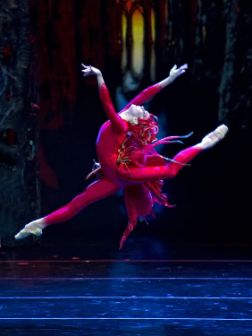
Startling: Natalia Osipova heads the flock. Photo courtesy of ABT by Gene Schiavone.
But we'll see if I agree with myself after I see it again. As beloved colleague Marina Harss has noted, Ratmansky ballets are layered enough to require a second viewing before you can really appreciate them. All the more when you've got other versions of the work on the brain. Do yourself a favor: see the ballet once to cleanse your palette--and a second time to enjoy.
The pas de deux between Ivan and the firebird is wonderful: a cautious rapprochement between captive wild animal and curious man. She doesn't know that he doesn't mean to ruin her. As a wild creature whose survival depends on eluding prey, she only understands polarities: total freedom or risk of death. In the course of the pas de deux, though, you see her beginning to experiment with the possibility of being touched but not destroyed. With the Fokine and the Balanchine, I've never been exactly sure when she is resisting and when relinquishing herself; these earlier productions subscribe to the Russian folktale obliviousness to the helpmates, the animals. The animals are always volunteering their services and doing triple duty for lazy human beings who take them for granted. There are many folk traditions that accord souls to animals they anthropomorphize. But the Russians, in their Christian orthodoxy, humanize them only to the extent that they prove useful. In this scheme of things, it only matters that the animals do the man's bidding; how they feel about it (if they do) is beside the point.
You may say, "What? You want to bowdlerize the tales?" And I say: how many Cinderella ballets do you know where the wicked step-sisters get their feet chopped off?
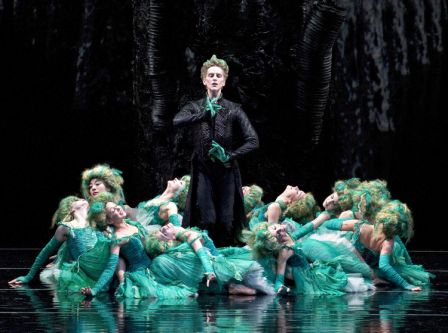
David Hallberg as conniving, imperious, sexy Kaschei and his delirious devotees. Ersatz love is a drug. Photo courtesy of ABT by Gene Schiavone.
Once the Maidens arrive, Ratmansky's Firebird begins to soar--and keeps soaring until the curtain comes down. This choreographer is always great with groups of women--in Namouna and with The Nutcracker snowflakes, for example. He gets the pathos: the mix of camaraderie and individual invisibility. By the time the Maidens converge on the scene--with Simone Messmer's endearing, comical Maiden in the lead--the ballet just gets funnier and funnier and more and more moving. At one point I began to laugh under my breath--like a feather were tickling my diaphragm--and didn't stop for five minutes. Ratmansky makes you love these people--this Ivan, this Maiden and her clique, even Kaschei--and respect the forever mysterious bird, who is not, as she has never been, loveable--no more than fire is.
For more on Ratmansky and his Firebird, here is a profile I wrote for the Financial Times a few months ago, for the ballet's world premiere in Los Angeles. And here is my addendum after seeing the remaining two casts, one with Isabella Boylston in the lead.
From my Financial Times review of Tchaikovsky Suite no. 3, playing only until Sunday at New York City Ballet:
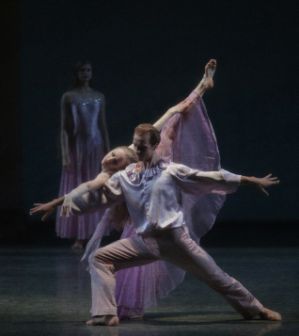 Teresa Reichlen splayed out as Ask la Cour meets the span of her legs. Photo by Paul Kolnik courtesy of the New York City Ballet.
Teresa Reichlen splayed out as Ask la Cour meets the span of her legs. Photo by Paul Kolnik courtesy of the New York City Ballet.
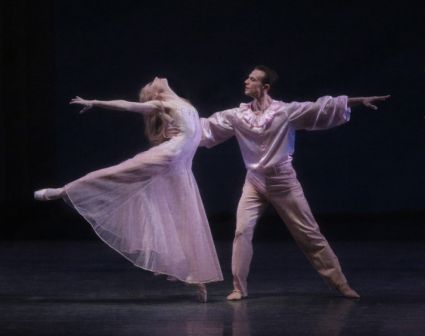 More swooning Romanticism (notice the man's collar!): Janie Taylor and Sebastian Marcovici in the backward-driving waltz. Photo by Paul Kolnik courtesy of the NYCB.
More swooning Romanticism (notice the man's collar!): Janie Taylor and Sebastian Marcovici in the backward-driving waltz. Photo by Paul Kolnik courtesy of the NYCB.
Balanchine discovered in Tchaikovsky, his fellow Petersburger, romance and imperial elegance entwined - or at least following fast on one another. But in this odd, late ballet, the choreographer kept them apart.
Tchaikovsky Suite No. 3 begins in a swoony state. Behind a foggy scrim, Ask la Cour kneeled in despair. The cause soon materialised: barefoot Venuses in long skirts of lilac tulle who did not do steps so much as drape themselves and their loose tresses around this forlorn dreamer.
 Teresa Reichlen splayed out as Ask la Cour meets the span of her legs. Photo by Paul Kolnik courtesy of the New York City Ballet.
Teresa Reichlen splayed out as Ask la Cour meets the span of her legs. Photo by Paul Kolnik courtesy of the New York City Ballet.
To find out what happens next, click here! Every click is a click for dance. And if you hit a registration wall, you only have to register once, ever after enjoying 30 articles a month free!
 More swooning Romanticism (notice the man's collar!): Janie Taylor and Sebastian Marcovici in the backward-driving waltz. Photo by Paul Kolnik courtesy of the NYCB.
More swooning Romanticism (notice the man's collar!): Janie Taylor and Sebastian Marcovici in the backward-driving waltz. Photo by Paul Kolnik courtesy of the NYCB.
At the end of this short review (click! click!), I mention how often Tchaikovsky travels between earth and air, small and large, soul and spirit. Because Tchaikovsky Suite No. 3 is all about such passages, transitions matter especially. And they extra especially matter in the final section, the theme and variations, which reiterates in dancing what the ballet as a whole lays out as drama.
A "Theme and Variations" aficionado might well respond, "But how can you tell the transition from the step in choreography where everything is exhibited and exposed, nothing hidden?"
Ahhhh, good question. I think the moments that need emphasis and are easily slid through are those just before a peak and just after. It can be the plie of takeoff, the switch from one leg supporting to the other, the moment the dancer changes direction but before she takes off. Paradoxically, accentuating these modest moments makes us feel the flow.
Here for your delectation is Gelsey Kirkland (who premiered the theme and variations section when it first appeared in Suite No. 3) with Baryshnikov in American Ballet Theatre's Theme and Variations in 1978. So this is what became the last section of Suite No. 3. Tape quality wretched, performance sublime. Sometimes they seem to stop altogether, as in stop-motion photography, but there is always something moving--the arms, the head.
This performance reminds me of something Kirkland said, I think in this 2010 interview with Joel Lobenthal and Laura Jacobs for Ballet Review, about how in order to seem light you have to use the floor, feel your weight. When dancers do not, the movement does not seem light, it seems flinty and false. In fact, it is false. Humans do not have wings; the only way we can seem to fly and evanesce is to use what we have: gravity and breath.
Fairchild and De Luz did not seem either flinty or false, just too careful (in this terrifying role) and not shaping it rhythmically.
The casting of roles that require speedy footwork for the women and bravado turning and jumping for the men has gotten rather predictable--limited to a few players-- over at New York City Ballet. Fairchild and De Luz (and Ashley Bouder) get the speedy roles every time out--and I like them, but this typecasting serves no one, least of all audiences, who want to see the breadth of a dancer, not just what we know they do well.
I'd love to see Sterling Hyltin, Abi Stafford, Tiler Peck, or Ashley Laracey in the "Theme" role, for example. As for men, maybe Andrew Veyette, Adam Hendrickson, or Robert Fairchild.
It's hard for me to come up with people the company might try out because New York City Ballet rarely does try its dancers out--it puts dancers in roles and keeps them there, or doesn't put them in roles and lets them rot, or picks three people to feature in so many roles at once that they inevitably get injured (witness: Sara Mearns). It promotes company members in advance of them proving themselves--publicly, at least. It's as if the powers that be cannot be bothered with trying out corps members or soloists in principal parts--and this in a company that Balanchine insisted not adhere to the usual ranking system. I should add: this is less true of the casting for Robbins--and may be why dancers featured early in Robbins (Rebecca Krohn, Mearns, Veyette, Hendrickson, Robert Fairchild, Wendy Whelan) are more likely to rise out of the corps (though what happens to them after they've risen is a crapshoot).
I'm not the only one dismayed at the tired casting, when it should be done with gusto for a company of so many fine dancers, who need to be challenged or at the very least remembered in order to continue to grow or even merely remain excellent. The Times' Alastair Macaulay also made this point in an otherwise favorable review of Martins' effects on the company. (For what it's worth, I agree with Macaulay's praises as well.)
In casting, American Ballet Theatre does much much better, which is ironic, isn't it, given it has always had a reputation as the company of the stars. And you can feel the difference. The company feels like a company--especially in the fall, when guest dancers aren't plunked down in roles they've learned elsewhere. When I go to see shows at ABT, I imagine all the balletmasters thinking about the year-round dancers up and down the ranks--where they might be featured. It's really heartening: how a company ought to be, especially in America, land of the free.
What's that? You have not yet clicked?
While you're reading, you can listen to a wonderful rendition of the full Tchaikovsky Suite: Charles Olivieri Munroe conducting the Slovenian Philharmonic.
AJ Blogs
AJBlogCentral | rssculture
About Last Night
Terry Teachout on the arts in New York City
Terry Teachout on the arts in New York City
Artful Manager
Andrew Taylor on the business of arts & culture
Andrew Taylor on the business of arts & culture
blog riley
rock culture approximately
rock culture approximately
critical difference
Laura Collins-Hughes on arts, culture and coverage
Laura Collins-Hughes on arts, culture and coverage
Dewey21C
Richard Kessler on arts education
Richard Kessler on arts education
diacritical
Douglas McLennan's blog
Douglas McLennan's blog
Dog Days
Dalouge Smith advocates for the Arts
Dalouge Smith advocates for the Arts
Flyover
Art from the American Outback
Art from the American Outback
lies like truth
Chloe Veltman on how culture will save the world
Chloe Veltman on how culture will save the world
Life's a Pitch
For immediate release: the arts are marketable
For immediate release: the arts are marketable
Mind the Gap
No genre is the new genre
No genre is the new genre
Performance Monkey
David Jays on theatre and dance
David Jays on theatre and dance
Plain English
Paul Levy measures the Angles
Paul Levy measures the Angles
Real Clear Arts
Judith H. Dobrzynski on Culture
Judith H. Dobrzynski on Culture
Rockwell Matters
John Rockwell on the arts
John Rockwell on the arts
State of the Art
innovations and impediments in not-for-profit arts
innovations and impediments in not-for-profit arts
Straight Up |
Jan Herman - arts, media & culture with 'tude
Jan Herman - arts, media & culture with 'tude
dance
Foot in Mouth
Apollinaire Scherr talks about dance
Apollinaire Scherr talks about dance
Seeing Things
Tobi Tobias on dance et al...
Tobi Tobias on dance et al...
jazz
Jazz Beyond Jazz
Howard Mandel's freelance Urban Improvisation
Howard Mandel's freelance Urban Improvisation
ListenGood
Focus on New Orleans. Jazz and Other Sounds
Focus on New Orleans. Jazz and Other Sounds
Rifftides
Doug Ramsey on Jazz and other matters...
Doug Ramsey on Jazz and other matters...
media
Out There
Jeff Weinstein's Cultural Mixology
Jeff Weinstein's Cultural Mixology
Serious Popcorn
Martha Bayles on Film...
Martha Bayles on Film...
classical music
Creative Destruction
Fresh ideas on building arts communities
Fresh ideas on building arts communities
The Future of Classical Music?
Greg Sandow performs a book-in-progress
Greg Sandow performs a book-in-progress
Overflow
Harvey Sachs on music, and various digressions
Harvey Sachs on music, and various digressions
PianoMorphosis
Bruce Brubaker on all things Piano
Bruce Brubaker on all things Piano
PostClassic
Kyle Gann on music after the fact
Kyle Gann on music after the fact
Sandow
Greg Sandow on the future of Classical Music
Greg Sandow on the future of Classical Music
Slipped Disc
Norman Lebrecht on Shifting Sound Worlds
Norman Lebrecht on Shifting Sound Worlds
The Unanswered Question
Joe Horowitz on music
Joe Horowitz on music
publishing
book/daddy
Jerome Weeks on Books
Jerome Weeks on Books
Quick Study
Scott McLemee on books, ideas & trash-culture ephemera
Scott McLemee on books, ideas & trash-culture ephemera
theatre
Drama Queen
Wendy Rosenfield: covering drama, onstage and off
Wendy Rosenfield: covering drama, onstage and off
visual
Aesthetic Grounds
Public Art, Public Space
Public Art, Public Space
Another Bouncing Ball
Regina Hackett takes her Art To Go
Regina Hackett takes her Art To Go
Artopia
John Perreault's art diary
John Perreault's art diary
CultureGrrl
Lee Rosenbaum's Cultural Commentary
Lee Rosenbaum's Cultural Commentary
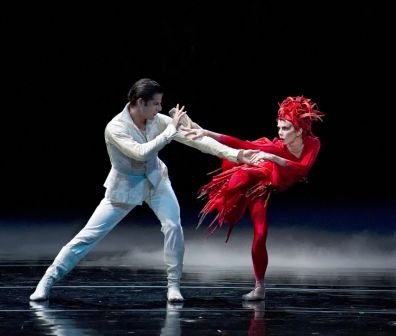

Recent Comments